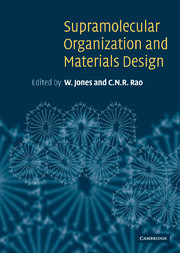Book contents
- Frontmatter
- Contents
- List of contributors
- Preface
- 1 Assembly and mineralization processes in biomineralization: strategies for forming biological composite materials
- 2 Mesoscale materials synthesis and beyond
- 3 Towards the rational design of zeolite frameworks
- 4 Mesoscale self-assembly: the assembly of micron-and millimeter-sized objects using capillary forces
- 5 Design of amphiphiles for the modulation of catalytic, membranous and gelation properties
- 6 Nanofabrication by the surface sol-gel process and molecular imprinting
- 7 The hierarchy of open-framework structures in metal phosphates and oxalates
- 8 Mesoscale self-assembly of metal nanocrystals into ordered arrays and giant clusters
- 9 Layered double hydroxides as templates for the formation of supramolecular structures
- 10 Molecular machines
- 11 Some aspects of supramolecular design of organic materials
- 12 Controlling crystal architecure in molecular solids: the supramolecular approach
- Index
2 - Mesoscale materials synthesis and beyond
Published online by Cambridge University Press: 18 December 2009
- Frontmatter
- Contents
- List of contributors
- Preface
- 1 Assembly and mineralization processes in biomineralization: strategies for forming biological composite materials
- 2 Mesoscale materials synthesis and beyond
- 3 Towards the rational design of zeolite frameworks
- 4 Mesoscale self-assembly: the assembly of micron-and millimeter-sized objects using capillary forces
- 5 Design of amphiphiles for the modulation of catalytic, membranous and gelation properties
- 6 Nanofabrication by the surface sol-gel process and molecular imprinting
- 7 The hierarchy of open-framework structures in metal phosphates and oxalates
- 8 Mesoscale self-assembly of metal nanocrystals into ordered arrays and giant clusters
- 9 Layered double hydroxides as templates for the formation of supramolecular structures
- 10 Molecular machines
- 11 Some aspects of supramolecular design of organic materials
- 12 Controlling crystal architecure in molecular solids: the supramolecular approach
- Index
Summary
Opening-up materials chemistry
For the latter half of the ‘Solid-State Twentieth Century’ materials science has been the engine that propelled technology. As we enter the ‘Materials Twenty-first Century’ it is abundantly clear that the insatiable demand for new materials for emerging technologies is driving materials science. Materials chemistry will play a central role in this endeavor through the creation of new materials with structures and properties able to meet the demands required by up-andcoming technologies. Recently, solid-state chemistry has moved beyond its first 50 years of thermodynamic phases and microscale structures to a new era of self-assembly materials chemistry and larger length scales, hierarchical structures and systems of integrated components. This phase in the development of solid-state chemistry focuses on metastable phases and on mesoscale and macroscale structures with accessible surfaces and well-defined interfaces between components that determine the overall function and utility of the material. The approach is interdisciplinary – it combines synthesis, solid-state architecture and functional hierarchy to create an innovative strategy for materials chemistry in the new millennium. The attractive feature of this direction is the ability to assemble complex structures rationally from inorganic, polymeric and organic modular components and to integrate them into self-assembling constructions for a range of perceived applications. By creating a series of purposeful materials design strategies it is believed that truly revolutionary advances in materials science and technology can result from this approach.
- Type
- Chapter
- Information
- Supramolecular Organization and Materials Design , pp. 34 - 82Publisher: Cambridge University PressPrint publication year: 2001
- 3
- Cited by

